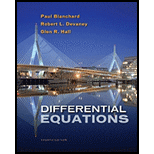
Concept explainers
Consider the following very simple model of blood cholesterol levels based on the fact that cholesterol is manufactured by the body for use in the construction of cell walls and is absorbed from foods containing cholesterol: Let C(t)be the amount (in milligrams per deciliter) of cholesterol in the blood of a particular person at time t(in days). Then
where
N = the person’s natural cholesterol level.
k1= production parameter.
E = daily rate at which cholesterol is eaten, and
k2= absorption parameter.
(a) Suppose N = 200,k1= 0.1,k2= 0.1,E = 400, and C(0)= 150. What will the person’s cholesterol level be after 2 days on this diet?
(b) With the initial conditions as above, what will the person’s cholesterol level be after 5 days on this diet?
(c) What will the person’s cholesterol level be after a long time on this diet?
(d) High levels of cholesterol in the blood are known to be a risk factor for heart disease. Suppose that, after a long time on the high cholesterol diet described above, the person goes on a very low cholesterol diet, so E changes to E = 100. (The initial cholesterol level at the starting time of this diet is the result of part (c).) What will the person’s cholesterol level be after 1 day on the new diet, after 5days on the new diet, and after a very long time on the new diet?
(e) Suppose the person stays on the high cholesterol diet but takes drugs that block some of the uptake of cholesterol from food, so k2changes to k2= 0.075. With the cholesterol level from part (c), what will the person’s cholesterol level be after 1 day, after 5 days, and after a very long time?
Trending nowThis is a popular solution!

Chapter 1 Solutions
Differential Equations
- Shading a Venn diagram with 3 sets: Unions, intersections, and... The Venn diagram shows sets A, B, C, and the universal set U. Shade (CUA)' n B on the Venn diagram. U Explanation Check A- B Q Search 田arrow_forward3. A different 7-Eleven has a bank of slurpee fountain heads. Their available flavors are as follows: Mountain Dew, Mountain Dew Code Red, Grape, Pepsi and Mountain Dew Livewire. You fill five different cups full with each type of flavor. How many different ways can you arrange the cups in a line if exactly two Mountain Dew flavors are next to each other? 3.2.1arrow_forwardBusinessarrow_forward
- Please explain how come of X2(n).arrow_forwardNo chatgpt pls will upvotearrow_forwardFind all solutions of the polynomial congruence x²+4x+1 = 0 (mod 143). (The solutions of the congruence x² + 4x+1=0 (mod 11) are x = 3,4 (mod 11) and the solutions of the congruence x² +4x+1 = 0 (mod 13) are x = 2,7 (mod 13).)arrow_forward
- https://www.hawkeslearning.com/Statistics/dbs2/datasets.htmlarrow_forwardDetermine whether each function is an injection and determine whether each is a surjection.The notation Z_(n) refers to the set {0,1,2,...,n-1}. For example, Z_(4)={0,1,2,3}. f: Z_(6) -> Z_(6) defined by f(x)=x^(2)+4(mod6). g: Z_(5) -> Z_(5) defined by g(x)=x^(2)-11(mod5). h: Z*Z -> Z defined by h(x,y)=x+2y. j: R-{3} -> R defined by j(x)=(4x)/(x-3).arrow_forwardDetermine whether each function is an injection and determine whether each is a surjection.arrow_forward
- Algebra & Trigonometry with Analytic GeometryAlgebraISBN:9781133382119Author:SwokowskiPublisher:Cengage


 Trigonometry (MindTap Course List)TrigonometryISBN:9781337278461Author:Ron LarsonPublisher:Cengage Learning
Trigonometry (MindTap Course List)TrigonometryISBN:9781337278461Author:Ron LarsonPublisher:Cengage Learning Algebra and Trigonometry (MindTap Course List)AlgebraISBN:9781305071742Author:James Stewart, Lothar Redlin, Saleem WatsonPublisher:Cengage Learning
Algebra and Trigonometry (MindTap Course List)AlgebraISBN:9781305071742Author:James Stewart, Lothar Redlin, Saleem WatsonPublisher:Cengage Learning Linear Algebra: A Modern IntroductionAlgebraISBN:9781285463247Author:David PoolePublisher:Cengage Learning
Linear Algebra: A Modern IntroductionAlgebraISBN:9781285463247Author:David PoolePublisher:Cengage Learning





